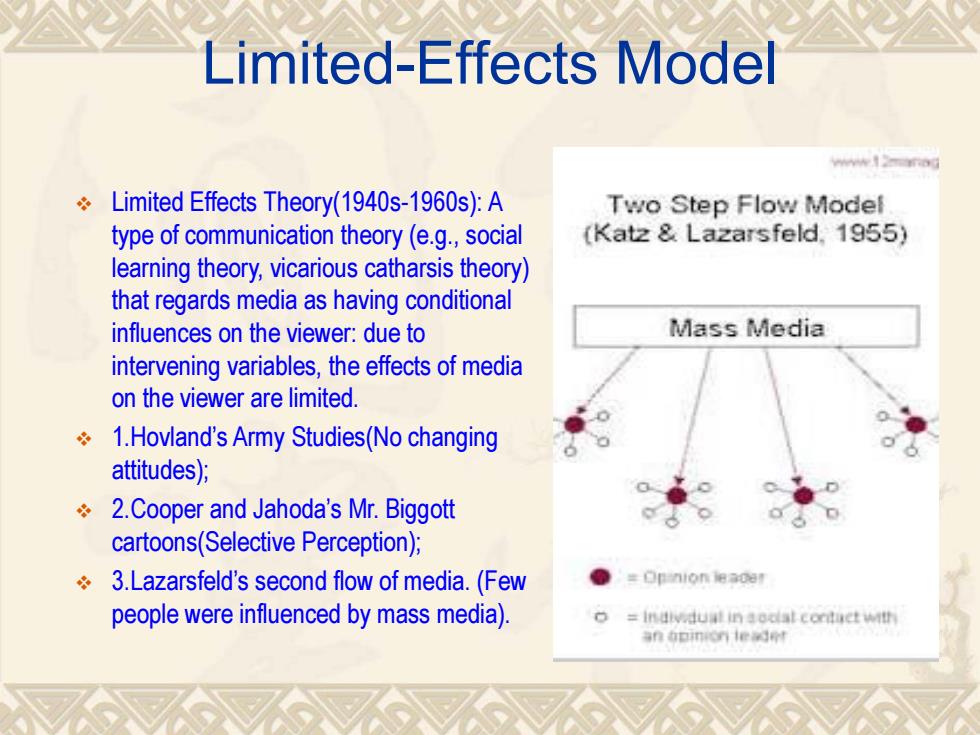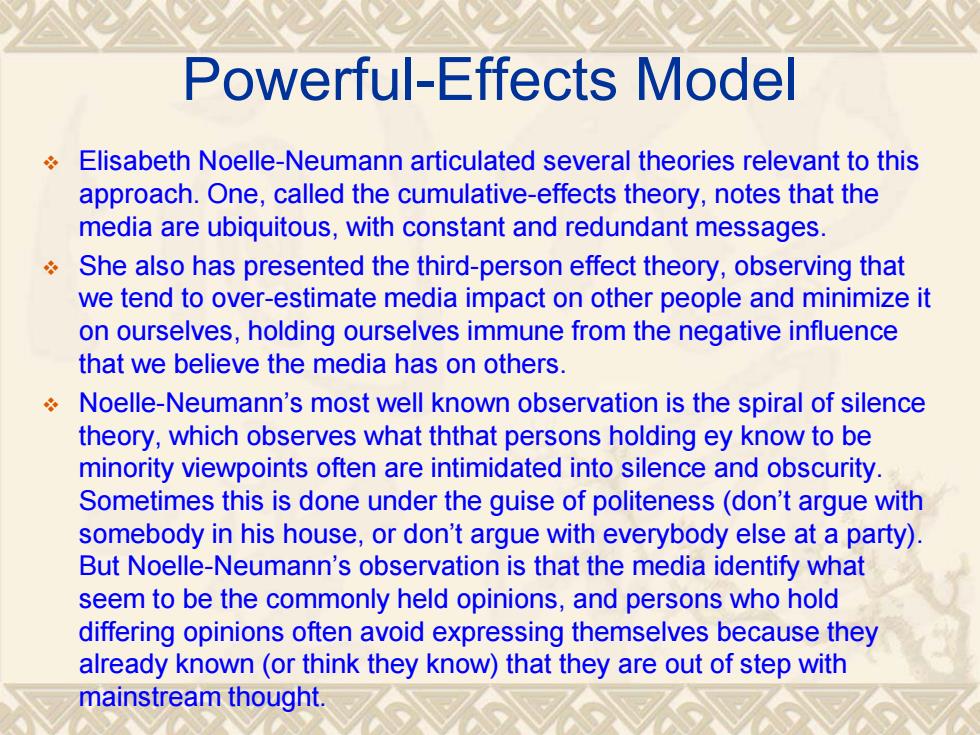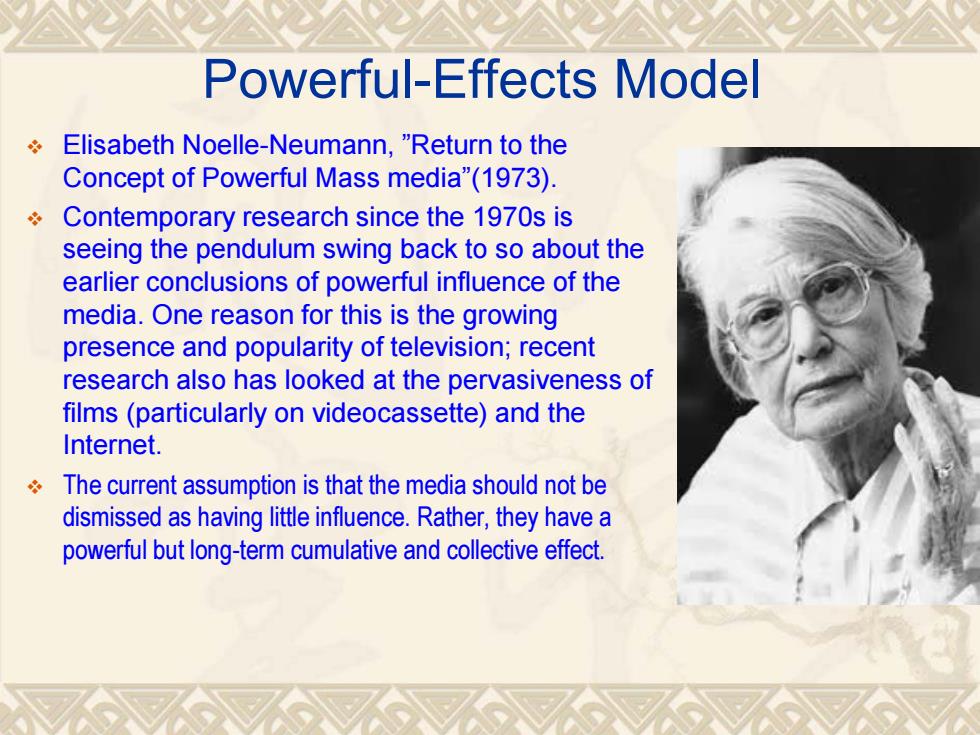
Limited-Effects Model Limited Effects Theory(1940s-1960s):A Two Step Flow Model type of communication theory (e.g.,social (Katz Lazarsfeld.1955) learning theory,vicarious catharsis theory) that regards media as having conditional influences on the viewer:due to Mass Media intervening variables,the effects of media on the viewer are limited. 1.Hovland's Army Studies(No changing attitudes); 2.Cooper and Jahoda's Mr.Biggott cartoons(Selective Perception); 3.Lazarsfeld's second flow of media.(Few 生0pn1onea0e people were influenced by mass media). Indiv duul in aodal cortuct witt n0卫n0neg
Limited-Effects Model Limited Effects Theory(1940s-1960s): A type of communication theory (e.g., social learning theory, vicarious catharsis theory) that regards media as having conditional influences on the viewer: due to intervening variables, the effects of media on the viewer are limited. 1.Hovland’s Army Studies(No changing attitudes); 2.Cooper and Jahoda’s Mr. Biggott cartoons(Selective Perception); 3.Lazarsfeld’s second flow of media. (Few people were influenced by mass media)

Limited-Effects Model The media may cause change within the audience as intended by the communicator,a result called conversion. The media may cause unintended change within an audience. The media may cause change that is only minor in form,intensity or duration.. The media may facilitate change(intended or not)that is actually caused by other social factors. The media may support the status quo, sustaining an audience in its beliefs or behavior rather than causing change.This is known as reinforcement. Finally,the media may prevent change,often through the propagandistic use of one-sided information aimed at an audience that would otherwise embrace change if it had all of the relevant information
Limited-Effects Model The media may cause change within the audience as intended by the communicator, a result called conversion. The media may cause unintended change within an audience. The media may cause change that is only minor in form, intensity or duration.. The media may facilitate change (intended or not) that is actually caused by other social factors. The media may support the status quo, sustaining an audience in its beliefs or behavior rather than causing change. This is known as reinforcement. Finally, the media may prevent change, often through the propagandistic use of one-sided information aimed at an audience that would otherwise embrace change if it had all of the relevant information

Powerful-Effects Model Elisabeth Noelle-Neumann articulated several theories relevant to this approach.One,called the cumulative-effects theory,notes that the media are ubiquitous,with constant and redundant messages. She also has presented the third-person effect theory,observing that we tend to over-estimate media impact on other people and minimize it on ourselves,holding ourselves immune from the negative influence that we believe the media has on others. Noelle-Neumann's most well known observation is the spiral of silence theory,which observes what ththat persons holding ey know to be minority viewpoints often are intimidated into silence and obscurity. Sometimes this is done under the guise of politeness(don't argue with somebody in his house,or don't argue with everybody else at a party) But Noelle-Neumann's observation is that the media identify what seem to be the commonly held opinions,and persons who hold differing opinions often avoid expressing themselves because they already known(or think they know)that they are out of step with mainstream thought
Powerful-Effects Model Elisabeth Noelle-Neumann articulated several theories relevant to this approach. One, called the cumulative-effects theory, notes that the media are ubiquitous, with constant and redundant messages. She also has presented the third-person effect theory, observing that we tend to over-estimate media impact on other people and minimize it on ourselves, holding ourselves immune from the negative influence that we believe the media has on others. Noelle-Neumann’s most well known observation is the spiral of silence theory, which observes what ththat persons holding ey know to be minority viewpoints often are intimidated into silence and obscurity. Sometimes this is done under the guise of politeness (don’t argue with somebody in his house, or don’t argue with everybody else at a party). But Noelle-Neumann’s observation is that the media identify what seem to be the commonly held opinions, and persons who hold differing opinions often avoid expressing themselves because they already known (or think they know) that they are out of step with mainstream thought

Powerful-Effects Model Elisabeth Noelle-Neumann,"Return to the Concept of Powerful Mass media"(1973). Contemporary research since the 1970s is seeing the pendulum swing back to so about the earlier conclusions of powerful influence of the media.One reason for this is the growing presence and popularity of television;recent research also has looked at the pervasiveness of films(particularly on videocassette)and the Internet. The current assumption is that the media should not be dismissed as having little influence.Rather,they have a powerful but long-term cumulative and collective effect
Powerful-Effects Model Elisabeth Noelle-Neumann, ”Return to the Concept of Powerful Mass media”(1973). Contemporary research since the 1970s is seeing the pendulum swing back to so about the earlier conclusions of powerful influence of the media. One reason for this is the growing presence and popularity of television; recent research also has looked at the pervasiveness of films (particularly on videocassette) and the Internet. The current assumption is that the media should not be dismissed as having little influence. Rather, they have a powerful but long-term cumulative and collective effect